
Surgery Partners (SGRY)
We’re not sold on Surgery Partners. Its growth has decelerated and its failure to generate meaningful free cash flow makes us question its prospects.― StockStory Analyst Team
1. News
2. Summary
Why Surgery Partners Is Not Exciting
With more than 180 locations across 33 states serving as alternatives to traditional hospital settings, Surgery Partners (NASDAQ:SGRY) operates a national network of outpatient surgical facilities including ambulatory surgery centers and short-stay surgical hospitals.
- Ability to fund investments or reward shareholders with increased buybacks or dividends is restricted by its weak free cash flow margin of 4.6% for the last five years
- High net-debt-to-EBITDA ratio of 6× could force the company to raise capital at unfavorable terms if market conditions deteriorate


Surgery Partners falls short of our expectations. We’d search for superior opportunities elsewhere.
Why There Are Better Opportunities Than Surgery Partners
High Quality
Investable
Underperform
Why There Are Better Opportunities Than Surgery Partners
Surgery Partners is trading at $15.64 per share, or 25.1x forward P/E. This multiple is higher than that of healthcare peers; it’s also rich for the business quality. Not a great combination.
We’d rather invest in similarly-priced but higher-quality companies with more reliable earnings growth.
3. Surgery Partners (SGRY) Research Report: Q3 CY2025 Update
Healthcare company Surgery Partners (NASDAQ:SGRY) met Wall Streets revenue expectations in Q3 CY2025, with sales up 6.6% year on year to $821.5 million. On the other hand, the company’s full-year revenue guidance of $3.29 billion at the midpoint came in 2% below analysts’ estimates. Its non-GAAP profit of $0.13 per share was 19% below analysts’ consensus estimates.
Surgery Partners (SGRY) Q3 CY2025 Highlights:
- Revenue: $821.5 million vs analyst estimates of $821.8 million (6.6% year-on-year growth, in line)
- Adjusted EPS: $0.13 vs analyst expectations of $0.16 (19% miss)
- Adjusted EBITDA: $136.4 million vs analyst estimates of $136.2 million (16.6% margin, in line)
- The company dropped its revenue guidance for the full year to $3.29 billion at the midpoint from $3.38 billion, a 2.6% decrease
- EBITDA guidance for the full year is $537.5 million at the midpoint, below analyst estimates of $556.1 million
- Operating Margin: 12.9%, up from 7.9% in the same quarter last year
- Free Cash Flow Margin: 7.8%, up from 5.8% in the same quarter last year
- Sales Volumes rose 3.4% year on year (5.4% in the same quarter last year)
- Market Capitalization: $2.74 billion
Company Overview
With more than 180 locations across 33 states serving as alternatives to traditional hospital settings, Surgery Partners (NASDAQ:SGRY) operates a national network of outpatient surgical facilities including ambulatory surgery centers and short-stay surgical hospitals.
Surgery Partners focuses on providing surgical procedures that don't require overnight hospital stays, such as orthopedic surgeries, ophthalmology procedures, gastroenterology treatments, and pain management interventions. These outpatient facilities are designed to be more efficient and cost-effective than traditional hospitals for planned, non-emergency procedures.
The company typically owns and operates its facilities through partnerships with physicians, physician groups, and healthcare systems. As of the end of 2023, Surgery Partners held majority ownership in 90 of its 162 surgical facilities. This partnership model allows physicians to maintain partial ownership while Surgery Partners provides management expertise, operational support, and capital resources.
Patients benefit from Surgery Partners' facilities by receiving specialized surgical care in convenient, focused environments that often offer shorter wait times and lower infection risks than larger hospitals. For example, a patient needing cataract surgery might visit a Surgery Partners ophthalmology-focused center, have the procedure performed in under an hour, and return home the same day.
The company generates revenue primarily through facility fees for services performed at its surgical centers. These fees come from a mix of government programs (like Medicare and Medicaid) and private insurance. Surgery Partners also earns management fees from the facilities it operates but doesn't fully own.
Beyond surgical facilities, the company offers complementary ancillary services including multi-specialty physician practices and anesthesia services. In states like Florida, Surgery Partners directly employs physicians, while in other states it operates physician practices through management service agreements with physician-owned professional corporations due to varying state regulations.
4. Outpatient & Specialty Care
The outpatient and specialty care industry delivers targeted medical services in non-hospital settings that are often cost-effective compared to inpatient alternatives. This means that they are more desired as rising healthcare costs and ways to combat them become more and more top-of-mind. Outpatient and specialty care providers boast revenue streams that are stable due to the recurring nature of treatment for chronic conditions and long-term patient relationships. However, their reliance on government reimbursement programs like Medicare means stroke-of-the-pen risk. Additionally, scaling a network of facilities can be capital-intensive with uneven return profiles amid competition from integrated healthcare systems. Looking ahead, the industry is positioned to grow as demand for outpatient services expands, driven by aging populations, a rising prevalence of chronic diseases, and a shift toward value-based care models. Tailwinds include advancements in medical technology that support more complex procedures in outpatient settings and the increasing focus on preventive care, which can be aided by data and AI. However, headwinds such as reimbursement rate cuts, labor shortages, and the financial strain of digitization may temper growth.
Surgery Partners' main competitors include other ambulatory surgery center operators such as United Surgical Partners International (owned by Tenet Healthcare, NYSE:THC), AmSurg (part of Envision Healthcare), HCA Healthcare (NYSE:HCA), and SCA Health (owned by Optum, a UnitedHealth Group company, NYSE:UNH).
5. Economies of Scale
Larger companies benefit from economies of scale, where fixed costs like infrastructure, technology, and administration are spread over a higher volume of goods or services, reducing the cost per unit. Scale can also lead to bargaining power with suppliers, greater brand recognition, and more investment firepower. A virtuous cycle can ensue if a scaled company plays its cards right.
With $3.29 billion in revenue over the past 12 months, Surgery Partners has decent scale. This is important as it gives the company more leverage in a heavily regulated, competitive environment that is complex and resource-intensive.
6. Revenue Growth
A company’s long-term sales performance is one signal of its overall quality. Any business can put up a good quarter or two, but the best consistently grow over the long haul. Luckily, Surgery Partners’s sales grew at a solid 12.4% compounded annual growth rate over the last five years. Its growth beat the average healthcare company and shows its offerings resonate with customers.
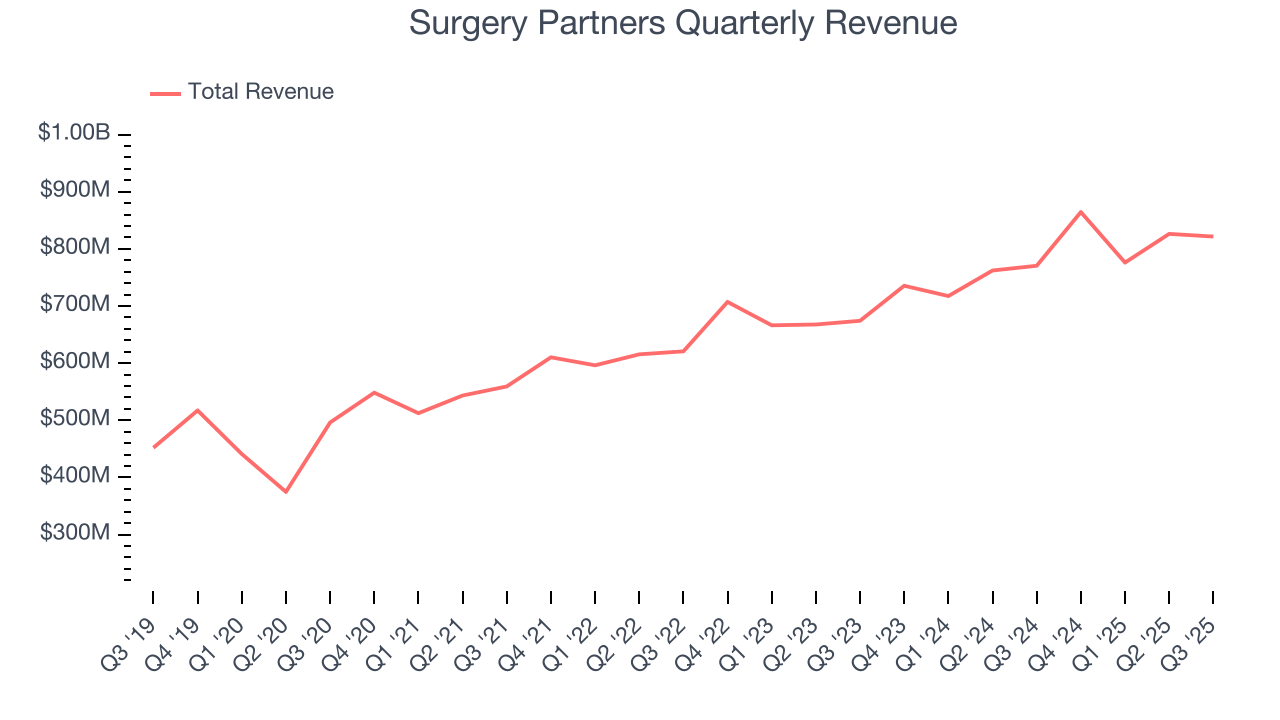
Long-term growth is the most important, but within healthcare, a half-decade historical view may miss new innovations or demand cycles. Surgery Partners’s annualized revenue growth of 10% over the last two years is below its five-year trend, but we still think the results were respectable. 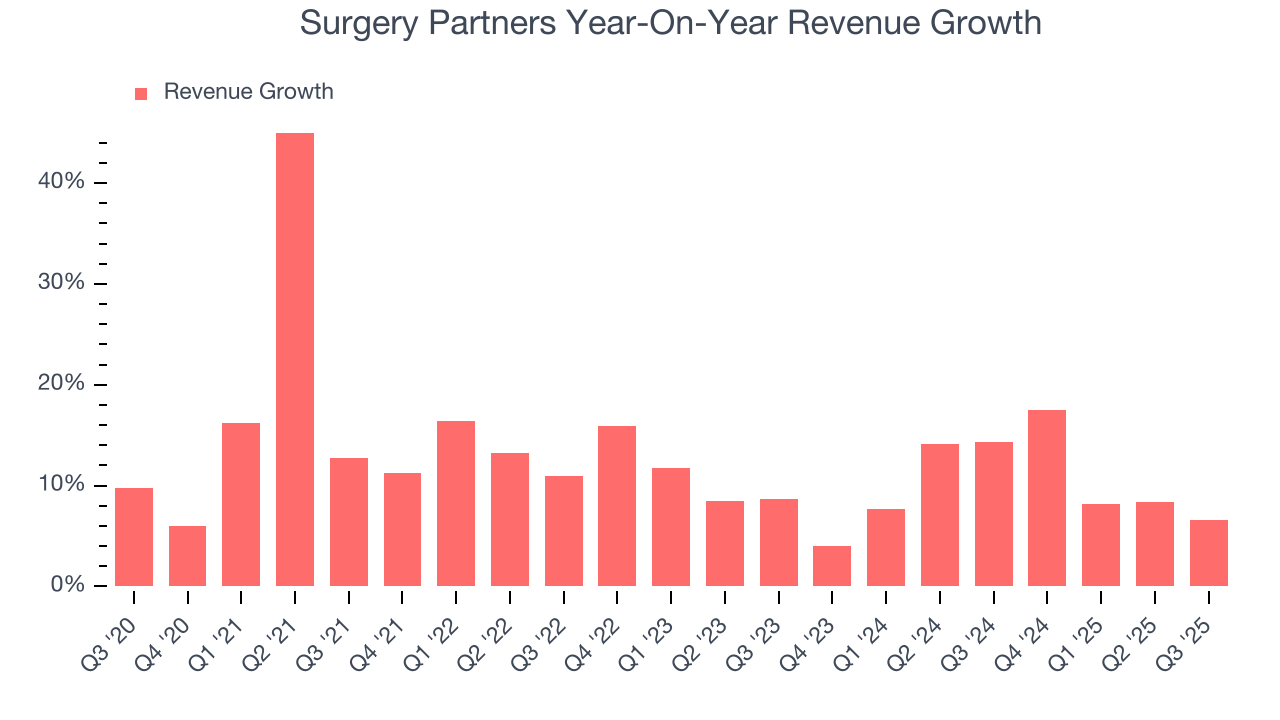
We can better understand the company’s revenue dynamics by analyzing its number of units sold. Over the last two years, Surgery Partners’s units sold averaged 3.8% year-on-year growth. Because this number is lower than its revenue growth, we can see the company benefited from price increases. 
This quarter, Surgery Partners grew its revenue by 6.6% year on year, and its $821.5 million of revenue was in line with Wall Street’s estimates.
Looking ahead, sell-side analysts expect revenue to grow 9.6% over the next 12 months, similar to its two-year rate. This projection is admirable and indicates the market sees success for its products and services.
7. Operating Margin
Surgery Partners’s operating margin has risen over the last 12 months and averaged 12.5% over the last five years. Its profitability was higher than the broader healthcare sector, showing it did a decent job managing its expenses.
Analyzing the trend in its profitability, Surgery Partners’s operating margin might fluctuated slightly but has generally stayed the same over the last five years. This raises questions about the company’s expense base because its revenue growth should have given it leverage on its fixed costs, resulting in better economies of scale and profitability.
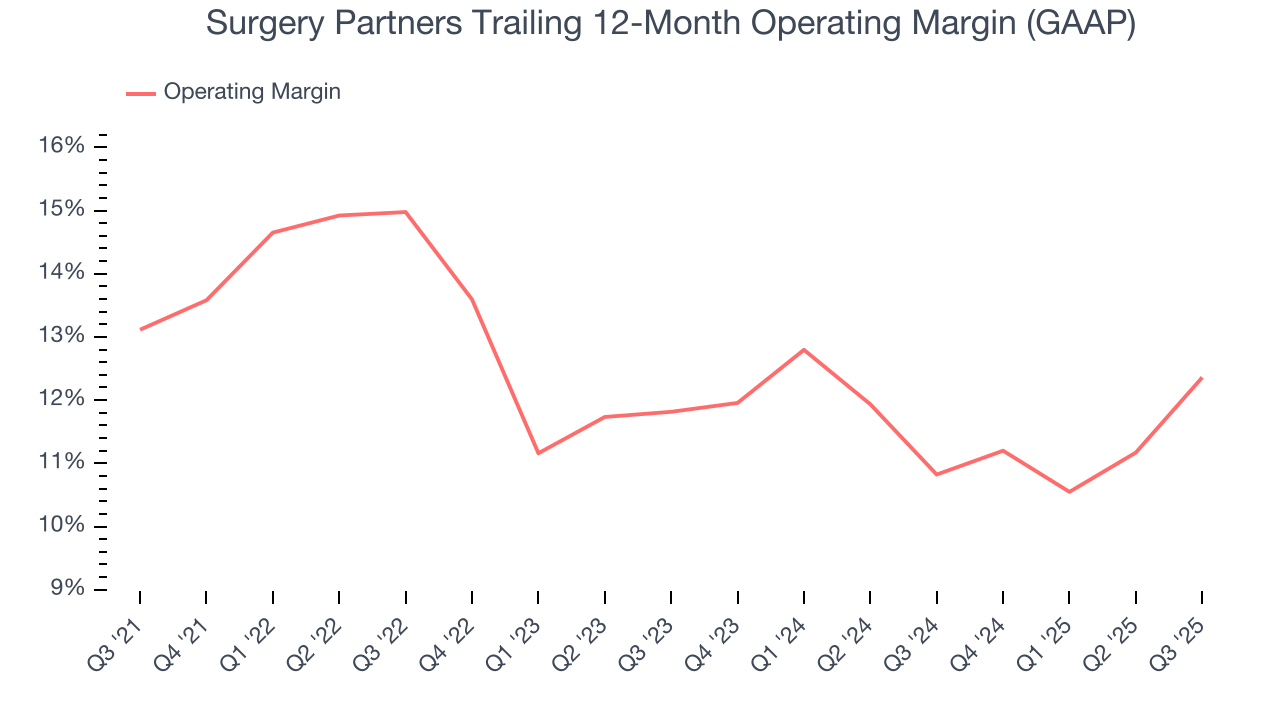
In Q3, Surgery Partners generated an operating margin profit margin of 12.9%, up 5 percentage points year on year. This increase was a welcome development and shows it was more efficient.
8. Earnings Per Share
Revenue trends explain a company’s historical growth, but the long-term change in earnings per share (EPS) points to the profitability of that growth – for example, a company could inflate its sales through excessive spending on advertising and promotions.
Surgery Partners’s full-year EPS flipped from negative to positive over the last five years. This is encouraging and shows it’s at a critical moment in its life.
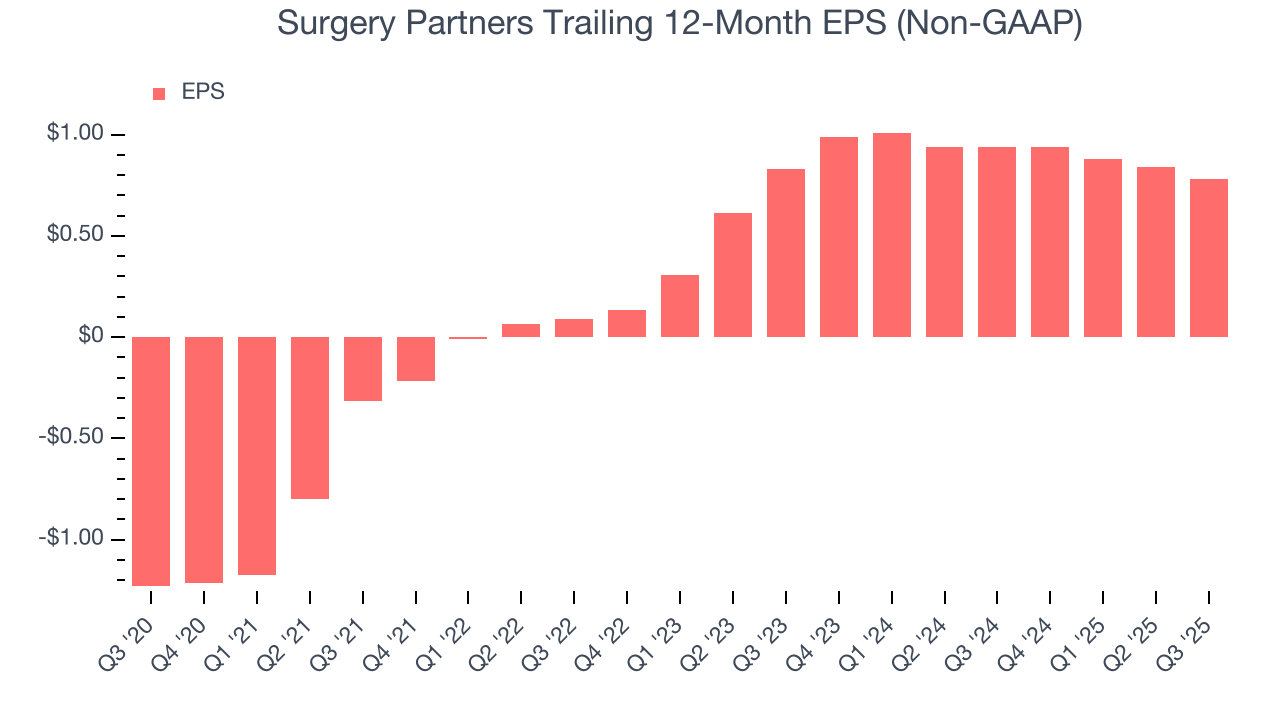
In Q3, Surgery Partners reported adjusted EPS of $0.13, down from $0.19 in the same quarter last year. This print missed analysts’ estimates, but we care more about long-term adjusted EPS growth than short-term movements. Over the next 12 months, Wall Street expects Surgery Partners’s full-year EPS of $0.78 to grow 28.6%.
9. Cash Is King
If you’ve followed StockStory for a while, you know we emphasize free cash flow. Why, you ask? We believe that in the end, cash is king, and you can’t use accounting profits to pay the bills.
Surgery Partners has shown mediocre cash profitability over the last five years, giving the company limited opportunities to return capital to shareholders. Its free cash flow margin averaged 4.6%, subpar for a healthcare business.
Taking a step back, an encouraging sign is that Surgery Partners’s margin expanded by 5.1 percentage points during that time. The company’s improvement shows it’s heading in the right direction, and we can see it became a less capital-intensive business because its free cash flow profitability rose while its operating profitability was flat.
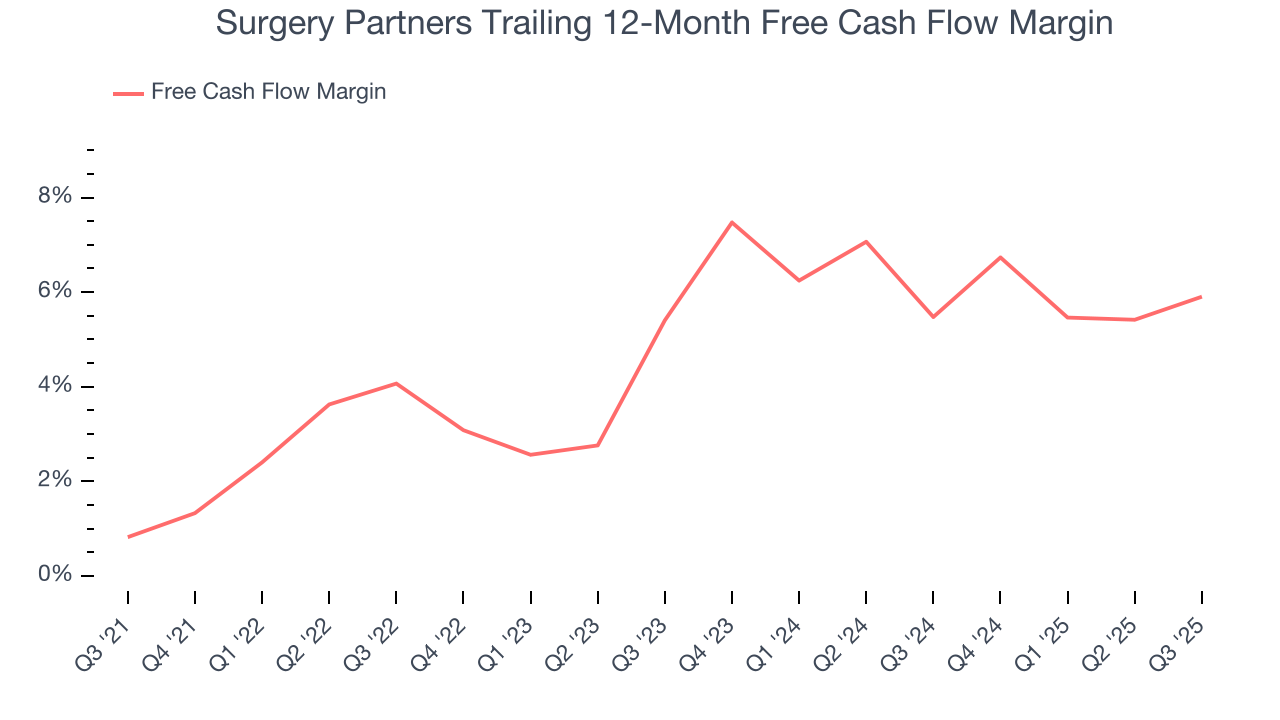
Surgery Partners’s free cash flow clocked in at $63.8 million in Q3, equivalent to a 7.8% margin. This result was good as its margin was 1.9 percentage points higher than in the same quarter last year, building on its favorable historical trend.
10. Return on Invested Capital (ROIC)
EPS and free cash flow tell us whether a company was profitable while growing its revenue. But was it capital-efficient? Enter ROIC, a metric showing how much operating profit a company generates relative to the money it has raised (debt and equity).
Surgery Partners’s management team makes decent investment decisions and generates value for shareholders. Its five-year average ROIC was 8.1%, slightly better than typical healthcare business.
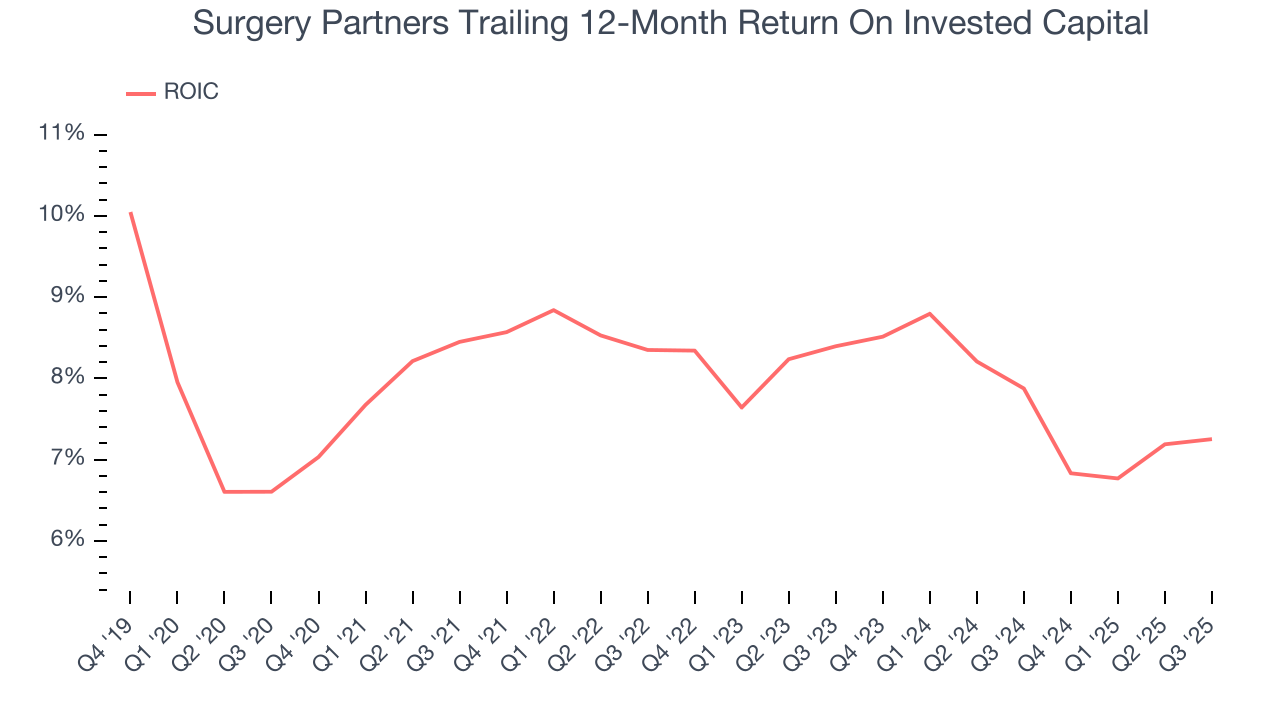
We like to invest in businesses with high returns, but the trend in a company’s ROIC is what often surprises the market and moves the stock price. Uneventfully, Surgery Partners’s ROIC has stayed the same over the last few years. Given the company’s underwhelming financial performance in other areas, we’d like to see its returns improve before recommending the stock.
11. Balance Sheet Risk
As long-term investors, the risk we care about most is the permanent loss of capital, which can happen when a company goes bankrupt or raises money from a disadvantaged position. This is separate from short-term stock price volatility, something we are much less bothered by.
Surgery Partners’s $3.56 billion of debt exceeds the $203.4 million of cash on its balance sheet. Furthermore, its 6× net-debt-to-EBITDA ratio (based on its EBITDA of $533.1 million over the last 12 months) shows the company is overleveraged.
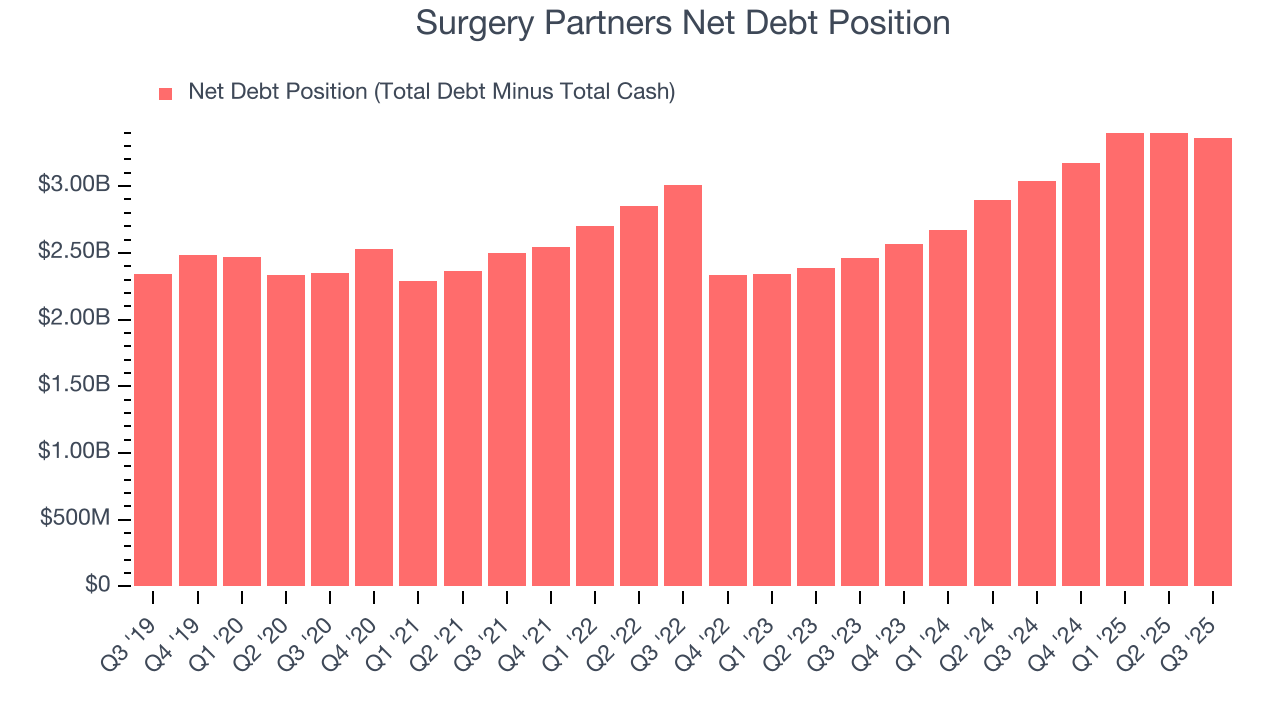
At this level of debt, incremental borrowing becomes increasingly expensive and credit agencies could downgrade the company’s rating if profitability falls. Surgery Partners could also be backed into a corner if the market turns unexpectedly – a situation we seek to avoid as investors in high-quality companies.
We hope Surgery Partners can improve its balance sheet and remain cautious until it increases its profitability or pays down its debt.
12. Key Takeaways from Surgery Partners’s Q3 Results
We were impressed by how significantly Surgery Partners blew past analysts’ sales volume expectations this quarter. On the other hand, its EPS missed. Looking ahead, its full-year revenue and full-year EBITDA guidance both fell short of Wall Street’s estimates. Overall, this quarter could have been better. The stock traded down 13.5% to $18.61 immediately after reporting.
13. Is Now The Time To Buy Surgery Partners?
Updated: December 24, 2025 at 11:38 PM EST
Before investing in or passing on Surgery Partners, we urge you to understand the company’s business quality (or lack thereof), valuation, and the latest quarterly results - in that order.
Aside from its balance sheet, Surgery Partners is a pretty decent company. To kick things off, its revenue growth was solid over the last five years. On top of that, Surgery Partners’s rising cash profitability gives it more optionality, and its astounding EPS growth over the last five years shows its profits are trickling down to shareholders.
Surgery Partners’s P/E ratio based on the next 12 months is 25.1x. All that said, we aren’t investing at the moment because its balance sheet makes us balk. Interested in this company and its prospects? We recommend you wait until it generates sufficient cash flows or raises money.
Wall Street analysts have a consensus one-year price target of $25.45 on the company (compared to the current share price of $15.64).













